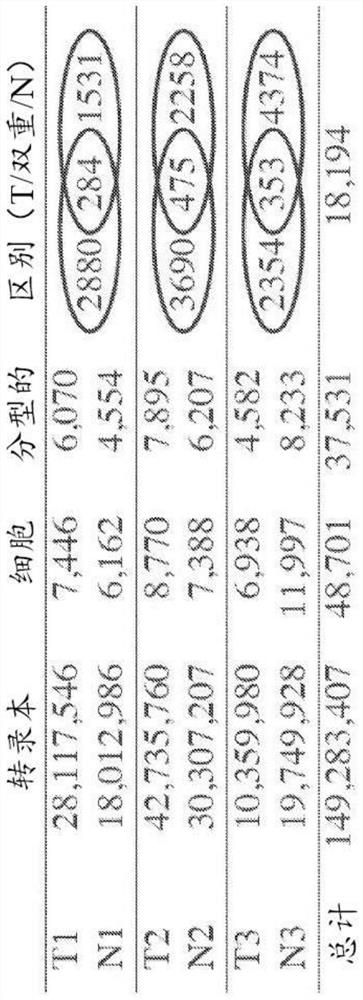Diagnostic methods and compositions for cancer immunotherapy
A cancer, chimeric antigen receptor technology, applied in the field of diagnosis and composition for cancer immunotherapy, which can solve problems such as difficulty in discovery and treatment
- Summary
- Abstract
- Description
- Claims
- Application Information
AI Technical Summary
Problems solved by technology
Method used
Image
Examples
example 1
[0813] Example 1. Correlation of T cell expansion patterns with different gene expression patterns in the tumor microenvironment and adjacent normal tissues
[0814]After T cells encounter their cognate antigen, clonal expansion can occur to generate multiple copies of the cell with a shared T cell receptor (TCR). Despite the fundamental role of clonal expansion in cancer immunity, little is known about the relationship between T cell subsets or antitumor responses in cancer patients. This example describes experiments to sequence TCR and RNA in single CD3+ T cells from primary non-small cell lung cancer and matched adjacent normal tissue (NAT). The data obtained from these studies indicated that, although the majority of clonotypes were represented by single cells, the remaining clonal lineages showed expansion only in NAT or tumor, or double-resident expansion in both compartments. Activated CD4+ T cells showed NAT expansion; resident memory T cells showed tumor expansion; ...
example 2
[0902] Example 2. Relationship Between Gene Expression Patterns and Responsiveness to PD-L1 Axis Binding Antagonist Therapy
[0903] In the TIL populations of the three patients analyzed in Example 1, the clonal residency pattern ( Figure 1D ) and T cell subsets were different. The different fractions of Tcyt, Tem and NKT cells in different patients were particularly obvious ( Figure 5A ). Therefore, it was explored whether gene expression patterns in the TIL population could correlate with clinical response to PD-L1 axis-binding antagonist therapy, such as atezolizumab. To this end, Gene Set Enrichment Analysis (GSEA) (Subramanian, A. et al. Proc Natl AcadSci USA 102, 15445–15550, 2005; and Lamb, J. et al. Science 313, 1929-1935, 2006) was applied to Pretreatment tumor RNA-seq data from a randomized clinical trial (POPLAR, (Fehrenbacher, L. et al. Lancet 387, 1837–1846 (2016))) in 193 patients with NSCLC in which the anti-PD-L1 antibody atezolizumab was compared with Th...
example 3
[0942] Example 3. Determining a patient's propensity to respond to PD-L1 axis binding antagonist therapy and treating the patient accordingly
[0943] Using the compositions and methods described herein, the likelihood of a cancer patient responding to therapy with a PD-L1 axis binding antagonist can be determined. For example, suffering from a cancer described herein such as lung cancer (e.g., non-small cell lung cancer), bladder cancer (e.g., urothelial carcinoma), kidney cancer (e.g., renal cell carcinoma), or breast cancer (e.g., triple-negative breast cancer) ) patients can receive one or more gene expression assays to determine whether the patient is likely to respond to agents including PD-L1 axis binding antagonists (e.g., PD-L1 binding antagonists (e.g., anti-PD-L1 antibodies, such as Treatment with zizumab (MPDL3280A)) or a PD-1 binding antagonist (eg, anti-PD-1 antibody)) resulted in a response. To determine this possibility, physicians can assay for genes CST7, NK...
PUM
 Login to View More
Login to View More Abstract
Description
Claims
Application Information
 Login to View More
Login to View More - R&D
- Intellectual Property
- Life Sciences
- Materials
- Tech Scout
- Unparalleled Data Quality
- Higher Quality Content
- 60% Fewer Hallucinations
Browse by: Latest US Patents, China's latest patents, Technical Efficacy Thesaurus, Application Domain, Technology Topic, Popular Technical Reports.
© 2025 PatSnap. All rights reserved.Legal|Privacy policy|Modern Slavery Act Transparency Statement|Sitemap|About US| Contact US: help@patsnap.com



